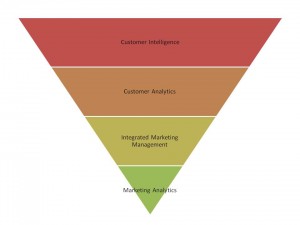 As mentioned in my previous post, there are a number of terms that describe how organizations manage their customer engagements: customer intelligence, customer analytics, integrated marketing management and marketing analytics. It's important to define them, as well as understand what comprises each term and know which SAS solutions apply. It's also important to know the reasons that these terms (or processes) are different and distinct.
As mentioned in my previous post, there are a number of terms that describe how organizations manage their customer engagements: customer intelligence, customer analytics, integrated marketing management and marketing analytics. It's important to define them, as well as understand what comprises each term and know which SAS solutions apply. It's also important to know the reasons that these terms (or processes) are different and distinct.
Let's focus first on our most overarching term: Customer Intelligence.
Looking back, we defined Customer Intelligence as the term that refers to the broadest category of customer software solutions that can be applied to not only marketing, but to other business functions as well, such as support, service operations, sales, etc. Every department in every organization has a need for information or intelligence about their end customer. The term customer intelligence thus brushes a broad stroke across all software that delivers information on an organization’s customer.
As you might imagine, a wide range of business issues can be addressed with SAS Customer Intelligence solutions - from collections optimization and profitability management to multi-channel campaign management and retention / loyalty programs. The key is to understand the most important factors for evaluating customer intelligence solutions. Of course, professional services, price, time to install, etc are possibly the most basic factors to consider. I'd like to focus on the more complex considerations, which I'm proposing as a “house“ construct - as if creating a long lasting prosperous relationship between vendor and organization.
A strong foundation.
Just as a well-built house begins with a solid foundation, a well-developed customer intelligence strategy also has a foundation - in this case, made up of data, analytics, and information management. In developing your customer intelligence strategy, I recommend you be sure your “data house“ is in order.In order to do that, focus on ways you can leverage data from a variety of sources, from customer social activity and influence, to combining online and offline activity and analytical data. The more accurate data you have on a customer – the better you can plan, execute, and optimize campaigns. This foundational data can include how a customer behaves across channels (outside the organization) as well as how a customer interacts with departments such as customer service, technical support, and operations (inside the organization). Start with a simple foundation (basic customer data) and then you can build a stronger foundation (more analytically based customer data) as information management becomes easier for your organization.
Sturdy walls and a roof.
Just as you can't imagine a house without walls and a roof, it's impossible to imagine customer intelligence without the means to engage your customers - through traditional multi channel campaign management, or marketing automation. SAS Customer Intelligence solutions are designed to feed customer information from multiple sources into a traditional inbound and outbound campaign management function. With the campaign management structure placed on a strong information management foundation, organizations have the makings of a solid solution framework.Electrical, Plumbing, Communicatons / Security.
These are the systems that are necessary elements without which the house is merely a structure. As mentioned, Customer Intelligence has very broad applicability, so it may help to think of it in terms of four categories:
- Strategy and planning tools These include ways for you to manage workflow and resource allocation, your marketing mix and specialized message delivery platforms.
- Information and analytical tools These enable you to derive insight from your organizational data and form the foundation for some of your more sophisticated analytical techniques.
- Campaign execution and optimization tools These provide the means to manage your interactions with customers across multiple channels, achieve real-time relevance and find the best actions to take.
- Customer experience tools These solutions help you monitor and measure customer value and provide your customers the best possible experience.
SAS Customer Intelligence solutions make a big impact on business strategy across industries. Consider these examples:
- RBC Dominion Securities uses Customer Intelligence in its advising departments.
- Globe Telecom uses SAS Customer Intelligence in its customer retention group.
- Lotte uses Customer Intelligence in its online group to improve customer experiences on its website.
- Chico’s uses Customer Intelligence in both its marketing and social groups to gain customer insight that translates to more successfull cross promotions.
Stay with me, as the next post will dive into our first sub-term - customer analytics! In the meantime, please share your thoughts with a comment. Thank you for following!

3 Comments
Pingback: What’s in a name – Integrated Marketing Management. - Customer Analytics
Pingback: What’s in a name – Marketing Analytics. - Customer Analytics
Pingback: closed loop marketing - SAS Customer intelligence - Integrated Marketing Management